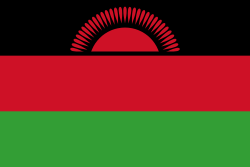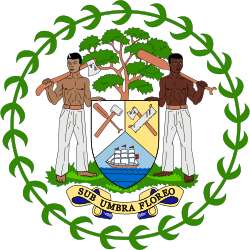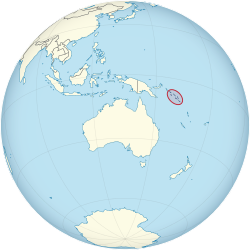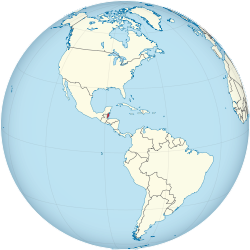Samväldesrike

Samväldesrike (engelska: Commonwealth realm) är var och en av de fjorton självständiga stater, bortsett från Storbritannien, vilka var för sig erkänner den person som är den brittiska monarken som sitt eget lands statschef.
Det innebär att kung Charles III innehar samtliga dessa befattningar då han, förutom att vara Storbritanniens kung, är monark för varje enskilt samväldesrike: exempelvis är han Nya Zeelands kung, men representeras lokalt av Nya Zeelands generalguvernör som utses på inrådan av Nya Zeelands premiärminister.
Samtliga samväldesriken är medlemmar av Samväldet (engelska: Commonwealth of Nations), en mellanstatlig organisation som är sammanslutning bestående av 53 självständiga stater, varav de flesta en gång i tiden utgjorde delar av det brittiska imperiet. Flertalet samväldesstater är numera republiker eller har en helt inhemsk monarki.
Bakgrund
Med start från kanadensiska konfederationen 1867 blev fler av de brittiska kolonierna, främst de med brittiska nybyggare, internt självstyrande som dominier. Efter första världskriget och under mellankrigstiden så utfärdades Balfourdeklarationen 1926 och Westminsterstatuten 1931 som formaliserade självständigheten men behöll lojaliteten till moderlandet genom en personalunion för statschefen.
Samväldesrikenas regeringar kom i december 1952 överens om att varje land eller dominion själv får lagstifta om de kungliga titlarna[1], och den sista lagen som reglerade monarkens titlar i hela imperiet var Titulärakten från 1927.
Utanför Förenade konungariket Storbritannien och Nordirland utnämner monarken, efter förslag av varje samväldesrikes regeringschef, en generalguvernör som sin personliga representant. Samväldesrikenas generalguvernörer är inte statschefer i egen rätt, men kan använda sig av i stort sett alla de befogenheter som tillkommer kungen i egenskap av vicekunglig representant, men i de flesta sammanhang fyller dessa endast en ceremoniell och upphöjd roll över dagspolitiken.
I samväldesriken som också är förbundsstater, Australien och Kanada, finns också en guvernör eller viceguvernör i varje delstat respektive provins som på lägre nivå fullföljer motsvarande plikter som i generalguvernörer i enhetsstater. Sedan Balfourdeklarationen 1926[2] får en generalguvernör inte längre agera på uppdrag av Förenade konungariket Storbritannien och Nordirlands regering utan skall representera monarken personligen eller respektive lands regering.
Nuvarande samväldesriken
| Namn och flagga | Folkmängd[3] | Kartbild | Statsvapen | Samväldesrike sedan | Notering |
|---|---|---|---|---|---|
| 99 175[3] |  |  | efter självständighet 1981 | [4] | |
| 25 809 973[3] |  |  | Dominion i brittiska imperiet från 1901 antog Westminsterstatuten 1942 (retroaktivt till 1939) | [5] | |
| 352 655[3] |  |  | efter självständighet 1973 | [6] | |
| 405 633[3] |  |  | efter självständighet 1981 | [7] | |
| 113 570[3] |  | 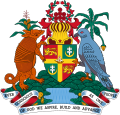 | efter självständighet 1974 | [8] | |
| 2 816 602[3] |  |  | efter självständighet 1962 | [9] | |
| 37 943 231[3] |  |  | Dominion i brittiska imperiet från 1867 antog Westminsterstatuten 1931 | [10] | |
| 4 991 442[3] |  |  | Dominion i brittiska imperiet från 1907 antog Westminsterstatuten 1947 | [11] | |
| 7 399 757[3] |  |  | efter självständighet 1975 | [12] | |
| 54 149[3] |  |  | efter självständighet 1983 | [13] | |
| 166 637[3] |  |  | efter självständighet 1979 | [14] | |
| 101 145[3] |  |  | efter självständighet 1979 | [15] | |
| 690 598[3] |  |  | efter självständighet 1978 | [16] | |
| 67 081 000[3] |  |  | – | [17] | |
| 11 448[3] |  |  | efter självständighet 1978 | [18] |
Tidigare samväldesriken
Tidigare har ytterligare nitton stater, förutom de femton befintliga, under någon period varit samväldesriken. Efter att de har avskaffat monarkin och infört ett republikanskt eller annat styrelseskick, har de dock med några få undantag kvarstått som medlemmar i Samväldet. Som medlemmar erkänner de fortsatt den brittiska kungen som överhuvud för den mellanstatliga organisationen Samväldet.
 Barbados (1966-2021), tillägg till konstitutionen[19][20]
Barbados (1966-2021), tillägg till konstitutionen[19][20] Ceylon (1948-1972), ny konstitution
Ceylon (1948-1972), ny konstitution Fiji (1970-1987), militärkupp
Fiji (1970-1987), militärkupp Gambia (1965-1970), folkomröstning
Gambia (1965-1970), folkomröstning Ghana (1957-1960), folkomröstning
Ghana (1957-1960), folkomröstning Guyana (1966-1970), tillägg till konstitutionen
Guyana (1966-1970), tillägg till konstitutionen Indien (1947-1950), ny konstitution
Indien (1947-1950), ny konstitution Irländska fristaten (1931-1949), lagstiftning
Irländska fristaten (1931-1949), lagstiftning Kenya (1963-1964), ny konstitution
Kenya (1963-1964), ny konstitution Malawi (1964-1966), ny konstitution
Malawi (1964-1966), ny konstitution Malta (1964-1974), tillägg till konstitutionen
Malta (1964-1974), tillägg till konstitutionen Mauritius (1968-1992), tillägg till konstitutionen
Mauritius (1968-1992), tillägg till konstitutionen Nigeria (1960-1963), tillägg till konstitutionen
Nigeria (1960-1963), tillägg till konstitutionen Pakistan (1947-1956), ny konstitution
Pakistan (1947-1956), ny konstitution Sierra Leone (1961-1971), ny konstitution
Sierra Leone (1961-1971), ny konstitution Sydafrikanska unionen (1931-1961), folkomröstning om republik 1960
Sydafrikanska unionen (1931-1961), folkomröstning om republik 1960 Tanganyika (1961-1962), ny konstitution
Tanganyika (1961-1962), ny konstitution Trinidad och Tobago (1962-1976), ny konstitution
Trinidad och Tobago (1962-1976), ny konstitution Uganda (1962-1963), tillägg till konstitutionen
Uganda (1962-1963), tillägg till konstitutionen
Tidslinje
Kronbesittningar
Jersey, Guernsey samt Isle of Man är brittiska öar och kronbesittningar under kung Charles III. De ingår inte i Förenade konungariket Storbritannien och Nordirland och de är inte heller samväldesriken då de inte är medlemmar i Samväldet.
Se även
Referenser
- Den här artikeln är helt eller delvis baserad på material från engelskspråkiga Wikipedia, Commonwealth realm, 18 oktober 2020.
Noter
- ^ An Act to provide for an alteration of the Royal Style and Titles (1953)
- ^ Balfour Declaration, 1926
- ^ [a b c d e f g h i j k l m n o p] ”Field Listing–Population” (på engelska). World Fact Book. Central Intelligence Agency. https://www.cia.gov/the-world-factbook/field/population. Läst 17 december 2021.
- ^ ”Antigua and Barbuda” (på engelska). www.royal.uk. Royal Household. https://www.royal.uk/antigua-and-barbuda-1. Läst 17 december 2021.
- ^ ”Australia” (på engelska). www.royal.uk. Royal Household. https://www.royal.uk/australia. Läst 17 december 2021. ”Australia is a constitutional monarchy with The Queen as Sovereign. As a constitutional monarch, The Queen, by convention, is not involved in the day-to-day business of the Australian Government, but she continues to play important ceremonial and symbolic roles.
The Queen's relationship to Australia is unique. In all her duties, she speaks and acts as Queen of Australia, and not as Queen of the United Kingdom.” - ^ ”The Bahamas” (på engelska). www.royal.uk. Royal Household. https://www.royal.uk/bahamas. Läst 17 december 2021. ”The Bahamas is a ‘constitutional monarchy’, meaning that The Queen has a unique relationship with the country. In all of her official duties relating to the many islands which make up The Bahamas, Her Majesty speaks and acts as Queen of The Bahamas, rather than Queen of the UK.”
- ^ ”Belize” (på engelska). www.royal.uk. Royal Household. https://www.royal.uk/belize. Läst 17 december 2021. ”Her Majesty is Head of State in Belize, meaning that she has a unique relationship with the central American country. In all her official duties relating to Belize, she speaks and acts as Queen of Belize, and not as Queen of the UK.”
- ^ ”Grenada” (på engelska). www.royal.uk. Royal Household. https://www.royal.uk/grenada. Läst 17 december 2021. ”Her Majesty is The Queen of Grenada, an island country in the Eastern Caribbean. This means that she has a unique relationship with the country: in all of her official duties relating to Grenada, she speaks and acts as Queen of Grenada, completely separate to her role as Queen of the UK.”
- ^ ”Jamaica” (på engelska). www.royal.uk. Royal Household. Arkiverad från originalet den 21 juni 2021. https://web.archive.org/web/20210621221442/https://www.royal.uk/jamaica. Läst 17 december 2021. ”Her Majesty is The Queen of Jamaica and, as such, continues to play an important ceremonial and symbolic role in Jamaican life. Jamaica is a constitutional monarchy with The Queen as Sovereign. In all of her official duties relating to Jamaica, The Queen speaks and acts as Queen of Jamaica, quite distinct from her role in the UK.”
- ^ ”Canada” (på engelska). www.royal.uk. Royal Household. https://www.royal.uk/canada. Läst 17 december 2021. ”The Queen has a unique relationship with Canada, entirely separate from her role as Queen of the United Kingdom or any of her other realms.
As in all her realms, The Queen of Canada is a constitutional monarch, acting entirely on the advice of Canadian Government ministers.” - ^ ”New Zealand” (på engelska). www.royal.uk. Royal Household. https://www.royal.uk/new-zealand. Läst 17 december 2021. ”New Zealand is a constitutional monarchy with The Queen as Sovereign. The Sovereign and the House of Representatives together make up the Parliament of New Zealand. As a constitutional monarch, The Queen of New Zealand acts entirely on the advice of New Zealand Government Ministers.”
- ^ ”Papua New Guinea” (på engelska). www.royal.uk. Royal Household. https://www.royal.uk/papua-new-guinea. Läst 17 december 2021. ”The Queen is Head of State in the South Pacific country of Papua New Guinea where she is known as 'Missis Kwin' and 'Mama belong big family' in Tok Pisin - a creole language spoken throughout the 600-plus islands which make up this sovereign state.
The Queen's relationship to Papua New Guinea is unique. In all her duties relating to Papua New Guinea , she speaks and acts as its Queen, and not as Queen of the United Kingdom.” - ^ ”St Christopher and Nevis” (på engelska). www.royal.uk. Royal Household. https://www.royal.uk/st-christopher-and-nevis. Läst 17 december 2021. ”Her Majesty is The Queen of St Christopher and Nevis, often known as St Kitts and Nevis, and as such she has a unique relationship with these two mountainous islands in the Eastern Caribbean. The Queen receives regular updates via her Governor-General on day-to-day matters of Government on the islands.”
- ^ ”St Lucia” (på engelska). www.royal.uk. Royal Household. https://www.royal.uk/st-lucia. Läst 17 december 2021. ”As Queen of St Lucia, Her Majesty maintains a unique relationship with this beautiful Eastern Caribbean island, keeping informed of day-to-day Government matters via her representative in the country, the Governor-General.
The Queen is a ‘constitutional monarch’ in St Lucia, meaning that she acts entirely on the advice of her Government ministers on the island who brief her regularly via her private secretaries.” - ^ ”St Vincent and the Grenadines” (på engelska). www.royal.uk. Royal Household. https://www.royal.uk/st-vincent-and-grenadines. Läst 17 december 2021. ”Her Majesty is The Queen of St Vincent and the Grenadines, a tropical island chain which lies at the southern tip of the Caribbean. Her Majesty is in regular contact with Government ministers in the country, and plays a significant symbolic role in island life: appearing on the nation's bank notes, and as the focus of annual birthday parade celebrations.
The Queen is a ‘constitutional Monarch’ in St Vincent and the Grenadines, meaning that she is not involved in the day-to-day business of Government, but she continues to play important ceremonial and symbolic roles.” - ^ ”Solomon Islands” (på engelska). www.royal.uk. Royal Household. https://www.royal.uk/solomon-islands. Läst 17 december 2021. ”Her Majesty is Queen of the Solomon Islands, and as such, she has a unique relationship with this remote group of islands in the south-west Pacific.
The Solomon Islands is a ‘constitutional monarchy’, meaning that The Queen is Head of State, though she acts entirely on the advice of her Government ministers in the country.” - ^ ”The Cabinet Manual, A guide to laws, conventions and rules on the operation of government” (på engelska). Cabinet Office. 2010. sid. 7. https://assets.publishing.service.gov.uk/government/uploads/system/uploads/attachment_data/file/60641/cabinet-manual.pdf. Läst 17 december 2021. ”In addition to the UK, the Sovereign is Head of State of a number of other Commonwealth realms.”
- ^ ”Tuvalu” (på engelska). www.royal.uk. Royal Household. https://www.royal.uk/tuvalu. Läst 17 december 2021. ”The Queen speaks and acts Queen of Tuvalu, not as Queen of the UK. She keeps up-to-date with local affairs via her Governor-General and Government ministers, and maintains an important symbolic role in Tuvalu, appearing on stamps and coins.”
- ^ ”Constitution (Amendment) (No. 2 ) Bill, 2021” (på engelska). History of this Bill. Barbados parlament. 2021. https://www.barbadosparliament.com/bills/details/581. Läst 7 november 2021.
- ^ ”Constitution (Amendment) (No. 2 ) Bill, 2021” (på engelska). Barbados parlament. 2021. https://www.barbadosparliament.com/uploads/bill_resolution/56f53e308108b4b315d1b367c2914f7a.pdf. Läst 7 november 2021.
Externa länkar
 Wikimedia Commons har media som rör samväldesrike.
Wikimedia Commons har media som rör samväldesrike.
Media som används på denna webbplats
Flag of Jamaica. “The sunshine, the land is green, and the people are strong and bold” is the symbolism of the colours of the flag. GOLD represents the natural wealth and beauty of sunlight; GREEN represents hope and agricultural resources; BLACK represents the strength and creativity of the people. The original symbolism, however, was "Hardships there are, but the land is green, and the sun shineth", where BLACK represented the hardships being faced.
Kanadas flagga, införd 1965; denna version med Pantone‐nyanser. Nuvarande utformning ersatte den tidigare kanadensiska Red Ensign.
Flag of South Africa, used between 1928 and 1982. It is identical to the 1982 to 1994 version except that the shade of blue is darker. It is also known as the "Oranje-Blanje-Blou".
Trinidad och Tobagos flagga
Författare/Upphovsman: TUBS
Location of XY (see filename) on the globe.
Författare/Upphovsman: TUBS
Location of XY (see filename) on the globe.
Författare/Upphovsman: TUBS
Location of XY (see filename) on the globe.
Författare/Upphovsman: TUBS
Location of XY (see filename) on the globe.
Författare/Upphovsman: Sodacan, Licens: CC BY-SA 4.0
National Emblem of Papua New Guinea (Adopted on 1 July 1971)
| “ | DESCRIPTION OF THE NATIONAL EMBLEM (National Identity Act 1971)
The Papua New Guinea National Emblem is a partiaIIy-stylized representation of the widespread Bird of Paradise Genus paradisaea in display, head turned to its left, seated on the upturned grip of a horizontal Kundu drum with the drum-head to the right side of the bird, from behind which a horizontal ceremonial spear projects with the head to the left of the bird. If coloured proper, the following colours should be used -- BIRD OF PARADISE
SPEAR
KUNDU DRUM
|
” |
Författare/Upphovsman: TUBS
Location of XY (see filename) on the globe.
Författare/Upphovsman: TUBS
Location of XY (see filename) on the globe.
Författare/Upphovsman: TUBS
Location of XY (see filename) on the globe.
Författare/Upphovsman: TUBS
Location of XY (see filename) on the globe.
Coat of arms from Antigua and Barbuda, retraced to SVG
Coat of arms of Belize
Flag of South Africa, used between 1928 and 1982. It is identical to the 1982 to 1994 version except that the shade of blue is darker. It is also known as the "Oranje-Blanje-Blou".
Commonwealth Coat of Arms of Australia granted by Royal Warrant signed by King George V on 19 September 1912.
IMPORTANT:This image is an artist's interpretation of the original (1912) official version of the Commonwealth Coat of Arms shown in Commons on the Australian coat of arms page. A variant of the original, with a transparent background, is shown on this page.
| “ | Quarterly of six, the first quarter Argent a Cross Gules charged with a Lion passant guardant between on each limb a Mullet of eight points Or; the second Azure five Mullets, one of eight, two of seven, one of six and one of five points of the first (representing the Constellation of the Southern Cross) ensigned with an Imperial Crown proper; the third of the first a Maltese Cross of the fourth, surmounted by a like Imperial Crown; the fourth of the third, on a Perch wreathed Vert and Gules an Australian Piping Shrike displayed also proper; the fifth also Or a Swan naiant to the sinister Sable; the last of the first, a Lion passant of the second, the whole within a Bordure Ermine; for the Crest on a Wreath Or and Azure A Seven-pointed Star Or, and for Supporters dexter a Kangaroo, sinister an Emu, both proper. | ” |
Författare/Upphovsman: Denelson83, Licens: CC BY-SA 3.0
Coat of arms of Tuvalu. Manually drawn using an image in the World Flag Database as a reference. The words "Tuvalu mo te atua" are the first line of Tuvalu's national anthem. Translated: "Tuvalu for the Almighty" (see: en:Tuvalu_mo_te_Atua)
Författare/Upphovsman: TUBS
Location of Solomon Islands on the globe.
Författare/Upphovsman: Prez001, Licens: CC BY-SA 3.0
Coat of Arms of St Vincent and the Grenadines.
Författare/Upphovsman: Sodacan, Licens: CC BY-SA 4.0
Coat of arms of Grenada, adopted in the summer 1974 following independence.
| “ | Quarterly, a cross Or, 1 & 4: Gules, a lion passant guardant Or, 2 & 4: Vert, a crescent and a lily Or; and in nombril point a picture of the Santa Maria. For a crest a golden helmet guardant, lambrequined Gules and with a wreath Argent and Gules, seven red roses surrounded with a garland of Bougainvillea-flowers. For supporters an armadillo (Tolypeutes tricinctus – Dasypodidæ) on the dexter, supporting a stalk of maize, and a Grenada dove (Leptotila wellsi) on the sinister, supporting a banana tree. On a ribbon an motto: EVER CONSCIOUS OF GOD WE ASPIRE, BUILD AND ADVANCE AS ONE PEOPLE. As a compartment the Mount St. Catherine and the lake Grand Étang. | ” |
Commonwealth realms and Dominions
Författare/Upphovsman: TUBS
Location of XY (see filename) on the globe.
Författare/Upphovsman: TUBS
Location of XY (see filename) on the globe.
Författare/Upphovsman: Diafora, Licens: CC BY-SA 3.0
Coat of Arms of Saint Lucia
| “ | The ROSE which you see on the coat of arms tells us about England. At one time England was our “mother” country because she was in charge of our affairs. The FLEUR-DE-LIS reminds us that we belonged to France as many as seven times. The Bamboo is our national plant, two pieces form the cross of the shield. The little AFRICAN STOOL in the centre is African and reminds us of our ancestors who were shipped from Africa during the slave trade. To light us on our way, we have a TORCH which is held up high. The Saint Lucian Parrot Amazona versicolor is our national bird guards each side of the Coat of Arms. Our Motto “THE LAND, THE PEOPLE, THE LIGHT”, is printed at the bottom of the shield. | ” |
Författare/Upphovsman: Prez001, Licens: CC BY-SA 3.0
Coat of arms of the Solomon Islands.
Författare/Upphovsman: TUBS
Location of Tuvalu on the globe.
Coat of arms of the Bahamas, mantling doubled argent (white)
Författare/Upphovsman: TUBS
Location of New Zealand on the globe.
Författare/Upphovsman: TUBS
Location of Belize on the globe.
Författare/Upphovsman: TUBS
Location of Grenada on the globe.
Författare/Upphovsman: Mysid, Licens: CC BY-SA 3.0
Flag of the Republic of Tanganyika
Coat of Arms of Saint Kitts and Nevis since 1983. This is an incorrect version, as the heraldic silver tincture is depicted with a shade of light blue.
Författare/Upphovsman: Sodacan, Licens: CC BY-SA 3.0
Coat of Arms of New Zealand (1956-Present)
- The Coat of Arms depict a shield with four quadrants divided by a central "pale". The first quadrant depicts the four stars on the flag of New Zealand; the second quadrant depicts a golden fleece, representing the nation's farming industry; the third depicts a sheaf of wheat for agriculture; and the fourth quadrant depicts crossed hammers for mining. The central pale depicts three galleys, representing New Zealand's maritime nature and also the Cook Strait. The Dexter supporter is a European woman carrying the flag of New Zealand, while the Sinister supporter is a Maori Warrior holding a Taiaha (Fighting weapon) and wearing a Kaitaka (flax cloak). The Shield is topped by the Crown of St. Edward, the Monarch of New Zealand's Crown. Below is a scroll with "New Zealand" on it, behind which (constituting the "heraldic compartment" on which the supporters stand) are two fern branches.























